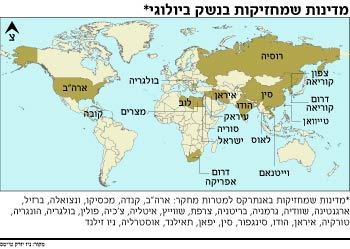Tamara Traubman

American geneticists said yesterday that they discovered genetic "fingerprints" that may help in discovering the laboratory from which the anthrax bacteria that were sent in envelopes to citizens in Florida were taken. The envelopes, which began to be sent in the fall, caused the death of five people.
FBI investigators have so far made little progress in the investigation, and have been unable to point to any suspects. The latest progress followed the decoding of the genome of the "Ames strain" - the anthrax strain that was isolated from envelopes sent to Florida. The decoding was reported in October by scientists from the "Brockville Genomic Research Institute", a research institute in the state of Maryland. During the decoding, the researchers identified the sequence of five million DNA units, which together constitute the genome in which all the biological information of the bacterium is written.
Yesterday, the "New York Times" published that the same researchers claim to have found a small number of characteristics, unique only to the Ames variety from Florida. Federal investigators will be able to try to find the same characteristics in the anthrax samples, collected from a dozen laboratories in the US and abroad, and thus possibly find out where the senders got the bacteria from.
"The genetic analysis of the anthrax reservoirs may give us a starting point for cracking the case," a senior federal official told the newspaper, adding that "the work is not yet finished, and its value is still unknown." Like other bacteria, anthrax reproduces by dividing into two bacteria. Usually, the new bacteria are identical to the original bacteria from which they split. However, in exceptional cases, mistakes occur in copying the DNA, and a bacterium with a slightly different genetic structure is created. The bacterium will also pass these differences on to its offspring, who in turn will pass them on to their offspring, and so on. Theoretically, the researchers could use this fact to trace the original bacteria used by the envelope senders.
Indeed, when the attacks began in the fall, the researchers hoped to identify the source of the bacteria by comparing it to a collection of nearly a hundred anthrax strains collected from different laboratories around the world. They tried to do this using the conventional identification methods, in which they look for complete DNA segments that repeat throughout the genome in unique patterns. However, these methods failed and so far the researchers have not been able to find differences between the variety of Ames strains from the different laboratories.
The researchers, who are now equipped with the complete sequence of the anthrax DNA units, hope that a more careful comparison - at the level of a single DNA unit - will allow them to identify, with the highest degree of probability, from which laboratory in the world the bacteria sent in the envelopes were taken.
https://www.hayadan.org.il/BuildaGate4/general2/data_card.php?Cat=~~~315747079~~~41&SiteName=hayadan
